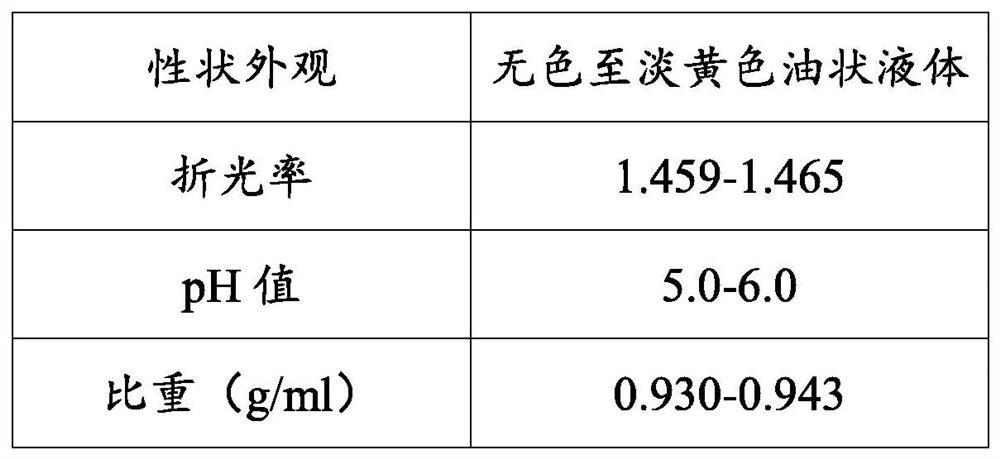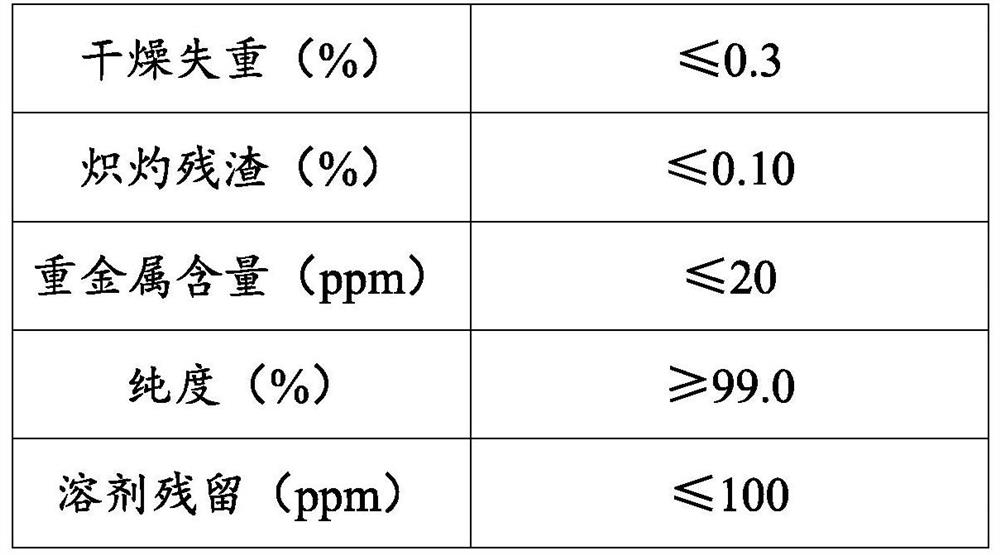Synthesis method of vitamin C tetraisopalmitate
A technology of palmitic acid ester and synthesis method, which is applied in the direction of organic chemistry, can solve the problems of excessive waste gas, waste water and waste residue, unstable raw material prices, complex synthesis methods, etc., and achieve the effects of low production cost, consistent performance, and simple reaction
- Summary
- Abstract
- Description
- Claims
- Application Information
AI Technical Summary
Problems solved by technology
Method used
Image
Examples
Embodiment 1
[0024] This embodiment provides a kind of synthetic method of vitamin C tetraisopalmitate, it comprises the following steps:
[0025] (1) 1 mol of vitamin C, aqueous sodium hydroxide solution and 7 mol of cyclohexane were mixed for 30 min, and placed in an ice bath at a temperature of 15° C., and then 3 mol of 2-hexyldecanoyl chloride ( Control the dropwise addition within 4 hours) to carry out the heat preservation reaction for 24 hours, and at the same time, an aqueous solution of sodium hydroxide can be added to make the reaction pH 9.5 to obtain a reaction solution. Wherein, the molar mass of sodium hydroxide in the aqueous solution of sodium hydroxide is 2mol.
[0026] (2) Pour the reaction solution into a separatory funnel and carry out static layering treatment for 0.1h, then take the upper layer to obtain the upper layer A.
[0027] (3) Add an aqueous oxalic acid solution with a mass concentration of 1% to the supernatant A for stratification, and take the upper layer...
Embodiment 2
[0031] This embodiment provides a kind of synthetic method of vitamin C tetraisopalmitate, it comprises the following steps:
[0032] (1) 1 mol of vitamin C, aqueous sodium hydroxide solution and 9 mol of cyclohexane were mixed for 30 min, and placed in an ice bath at a temperature of 5° C., and then 5 mol of 2-hexyldecanoyl chloride ( Control the dropwise addition within 4 hours) to carry out the heat preservation reaction for 24 hours, and at the same time, an aqueous solution of sodium hydroxide can be added to make the reaction pH 10 to obtain a reaction solution. Wherein, the molar mass of sodium hydroxide in the aqueous solution of sodium hydroxide is 4mol.
[0033] (2) Pour the reaction solution into a separatory funnel for static layering treatment for 1 h, then take the upper layer to obtain the upper layer A.
[0034] (3) Add an aqueous oxalic acid solution with a mass concentration of 3% to the supernatant A for stratification, and take the upper layer to obtain a ...
Embodiment 3
[0038] This embodiment provides a kind of synthetic method of vitamin C tetraisopalmitate, it comprises the following steps:
[0039] (1) 1 mol of vitamin C, aqueous sodium hydroxide solution and 8 mol of cyclohexane were mixed for 30 min, and placed in an ice bath at a temperature of 15° C., and then 4 mol of 2-hexyldecanoyl chloride ( Control the dropwise addition within 4 hours) to carry out the heat preservation reaction for 24 hours, and at the same time, an aqueous solution of sodium hydroxide can be added to make the reaction pH 9.8 to obtain a reaction solution. Wherein, the molar mass of sodium hydroxide in the aqueous solution of sodium hydroxide is 3mol.
[0040] (2) Pour the reaction solution into a separatory funnel and carry out static layering treatment for 0.5h, then take the upper layer to obtain the upper layer A.
[0041] (3) Add an aqueous oxalic acid solution with a mass concentration of 2% to the supernatant liquid A for stratification, and take the uppe...
PUM
 Login to View More
Login to View More Abstract
Description
Claims
Application Information
 Login to View More
Login to View More - R&D
- Intellectual Property
- Life Sciences
- Materials
- Tech Scout
- Unparalleled Data Quality
- Higher Quality Content
- 60% Fewer Hallucinations
Browse by: Latest US Patents, China's latest patents, Technical Efficacy Thesaurus, Application Domain, Technology Topic, Popular Technical Reports.
© 2025 PatSnap. All rights reserved.Legal|Privacy policy|Modern Slavery Act Transparency Statement|Sitemap|About US| Contact US: help@patsnap.com


